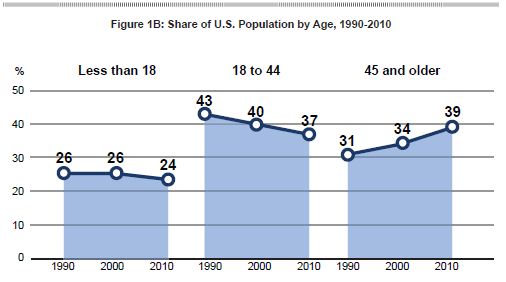How the Church Should Respond to the Uneven Aging of America
Sam Rainer
America does not age evenly. Brookings recently released a new report giving a state-by-state breakdown of the fastest growing “younger” and “older” areas of the country. Here’s a summary of a few of their findings:
- Between 2000 and 2010, the population over 45 grew 18 times as fast as the population under 45.
- Seniors gravitated towards the Sun Belt states in the past, but many Boomers are “aging in place” today, resulting in places like Raleigh, NC and Madison, WI having fast-growing Boomer populations.
- The younger generation is migrating geographically to the Sun Belt states.
- Suburbs are aging much faster than cities.
What are some general responses to these trends? Allow me to share a few insights.
Know your community. National trends are helpful to understand the culture of America. It’s more important to the local church, however, to understand the micro trends in your own community. For instance, if you live in an aging suburb, the same type of ministry that grew your church 20 years ago may cause it to stagnate or decline today.
Boomers are not seniors. I’ve blogged on this subject before, but it’s important to understand. Most Boomers prefer not to be lumped into a ministry with their parents. They are an entirely different generation. Boomer ministries are huge growth areas of the church that remain largely untapped. With so many Boomers retiring, perhaps a lay-led revolution could take place in the church with these ministries. Perhaps a revival could take place in this generation as they enter a new season of life.
Go to the next generation. We need more church plants everywhere, but we need them especially in the Sun Belt states and in cities that are attracting the younger generation. We also need brave pastors in these areas to lead their established churches through a difficult process of change to position their congregations to reach the next generation.
Homogeneous strategies will not work. What this report does not reveal is the ethnic breakdown of aging (although Brookings has done other reports on it). But this year marks the first time that minority babies make up the majority of births in America. In a few years, preschools will become minority white. The older generation—as much as 80% white—is vastly different than the younger generation in ethnic diversity. Churches using the same homogeneous strategies of the past will find them completely irrelevant today. This trend is already in full swing, so you must change now. How churches respond to this trend, more than any other demographic trend, will be what makes or breaks individual congregations.
If we are going to reach the younger generation, then we must do more than simply have a welcoming attitude towards diversity. We’ve got to be intentional about growing churches with a culture of heterogeneity. A great opportunity exists to make a visible—and generational—statement about unity in diversity through the body of Christ.








Sam –
Outstanding post! I wish every church could see how we need to reach our communities. More and more, churches do not reflect the diversity of the community in which they serve. They thus become a isolated social club rather than a missional sending agency into the demographics they should be serving and reaching. You are absolutely on target.
I fully support your comments! How can you lead a soul to Heaven, if you can’t get a soul to listen here on earth? Open the doors, open your arms, open your hearts! I’m not suggesting anything unscriptural, not at all, but walk in the steps of Jesus, eat with the sinners, go where they are and “bring them in”.
Thanks for the inspiration in your message. I pray it will fall on good soil!